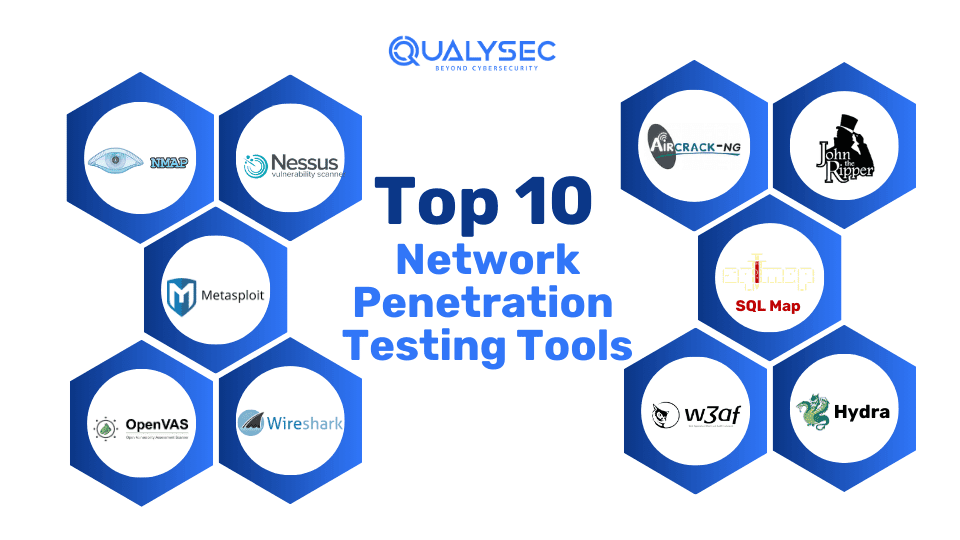As firms spread their operations worldwide, the need to protect their networks remains a significant concern regardless of the size of the enterprise. Additionally, the constant increase of cyber threats and data leaks requires Network Penetration Testing Tools as preventive measures to detect risks in an organizational network.
Penetration testing or ethical hacking is a security check in which a third party tries to hack into a system to assess vulnerabilities. Hence, you can manage them before the bad guys take advantage of them.
Below is a list of the top 10 pentesting tools that every security professional should know.
What is Network Penetration Testing?
Network penetration testing, commonly called pen testing, involves an authorized attempt to breach a computer network to expose its security weaknesses. It, therefore, is carried out by ethical hackers who are professionals to test your security loopholes using network penetration testing tools. The purpose is to identify and resolve such weaknesses before someone else tries to hack your system.
Pen testing is more like running a training exercise on your network and its security measures. Thus, it assists a company in knowing the areas of weakness within its security and how the attackers can penetrate the company’s systems.
Benefits of Network Penetration Testing
Here are some of the benefits of network penetration testing:
1. Improved Security Posture
Penetration testing will assist in pointing out those areas that are vulnerable before the attackers notice and exploit them. Additionally, using the best network penetration testing tools enables you to implement changes that might strengthen your security position and make it challenging for intruders to breach your systems.
2. Reduced Risk of Breaches
Penetration testing is the process that can minimize this risk since it pinpoints areas of weaknesses in an organization’s system that could lead to a data violation. Leaks of critical information might have severe consequences for an organization, therefore, leading to high expenses and lost credibility.
3. Enhanced Compliance
Several regulations demand organizations to carry out penetration testing at set intervals. Moreover, the procedures used in penetration testing will also help you ensure that you comply with industry regulations like GDPR, HIPAA, PCI DSS, etc.
4. Better Decision-Making
The results obtained by penetration testing contribute to improved decision–making on where to spend your money to implement security controls.
Key Factors for Selecting the Best Network Penetration Testing Tools
Selecting the appropriate network security testing tools is vital so you can mimic an attack and determine how secure your network is. Here are the key factors to consider when selecting the best tools for your needs:
1. Feature Set and Capabilities
Tools with extensive coverage should include different testing methods (for example, vulnerability scanning, exploitation, and password cracking) to have all the potential security gaps discovered.
2. Accuracy and Reliability
Further, the tools should not present false positive/negative reports because findings must be valid for better decision-making and rectification action.
3. Ease of Use and Integration
Ease of use and compatibility with other systems make testing or incorporating in an entity’s processes easier.
4. Reporting and Analysis:
Valuable tools provide concise and prescriptive reports indicating the high-priority vulnerabilities and their remedies, which help assess vulnerability.
Would you like to see a network penetration test report? Click on the link below to see how the details of the pentest report can help you succeed in your business!
Latest Penetration Testing Report

5. Support and Community
The stability of the tool and its continuous improvement can be further provided by regular access to support, updates, and a vast base of users.
List of the 10 Best Network Penetration Testing Tools
Here is a list of free network penetration testing tools:
1. Nmap
Creator: Gordon Lyon
Nmap is an open-source, free tool for any operating system and network. Additionally, it is commonly referred to as the best tool for mapping networks. In particular, it can show which devices, services, and operating systems are available on the network, which can be valued when searching for a vulnerability.
2. Nessus
Creator: Tenable
Nessus is a highly effective tool for performing vulnerability analysis that may pinpoint numerous security issues with devices, apps, and OSS (operations support systems). It has a massive database with descriptions of vulnerabilities and information about the level of threat that each vulnerability can pose.
3. Metasploit
Creator: Rapid7
Metasploit is the most effective penetration testing tool that collects a comprehensive database of exploits, tools, payloads, etc. Additionally, it makes it possible to launch actual attacks and check the efficiency of protection in an environment without danger.
4. OpenVAS
Creator: Open Vulnerability Assessment Scanner Consortium
OpenVAS is another vulnerability scanner that is very similar in function to Nessus, though OpenVAS is an open-source program in contrast to Nessus. Furthermore, it provides several features, mainly vulnerability scan, configuration analysis, and reporting tools.
5. Wireshark
Creator: Wireshark Project
Wireshark is a tool for analyzing network traffic and can capture packets using the available protocols. This can be useful in detecting potential security threats, for example, threats in the form of malware or intrusion attempts.
6. Aircrack-ng
Creator: Thomas d’Otreppe de Bouvette
A collection of tools for auditing wireless networks is called Aircrack-ng. It can undertake attacks to test the resilience of network security, capture packets, and crack WEP and WPA-PSK keys.
7. SQLMap
Creator: Miroslav Stampar
SQLMap is an open-source penetration testing tool that automates the detection and exploitation of SQL injection vulnerabilities. It works with a variety of database management systems and can extract database fingerprints, and data, and access underlying file systems.
8. John the Ripper
Creator: Openwall
John the Ripper is a quick password cracker that detects weak passwords and enhances network security. It supports various password hash types and can carry out dictionary and brute force attacks.
9. W3af
Creator: Andres Riancho
The open-source web application attack and audit framework is intended to uncover vulnerabilities in applications and networks. It supports both automated and manual testing, as well as a variety of plugins for complete security testing.
10. Hydra
Creator: Van Hauser/ The THC Team
Hydra is a parallelized login cracker that can perform brute-force assaults using a variety of protocols. It is used to determine the strength of usernames and passwords by attempting various combinations on network services.
Does your company need a network penetration test? Consult our knowledgeable security experts for free now!
Talk to our Cybersecurity Expert to discuss your specific needs and how we can help your business.
Conclusion
Network penetration testing is essential to strong security measures within the organizational network. Thus, using network penetration testing tools listed above, network penetration testing helps security specialists find potential threats that cybercriminals can use.
However, it is necessary to stress that network penetration testing is not an exclusive task but a continuous process. One key component that can aid network and data security is performing periodic tests and assessments with network pen testing tools. It is such a proactive approach that assists in preventing or counteracting threats that may compromise the security of the network and its associated support structures.
FAQs
1. What are the five-network penetration testing techniques?
A. The five-network penetration testing techniques are:
- Vulnerability Scanning
- Enumeration
- Password Attacks
- Exploit Attacks
- Firewall testing
2. What are the three types of penetration tests?
A. The three types of penetration testing:
- Black Box Testing
- White Box Testing
- Gray Box Testing
3. What tool is used for penetration testing?
A. Some of the tools used for penetration testing are:
- Nmap
- Burp Suite
- Netsparker
















































































































































































































































































































0 Comments